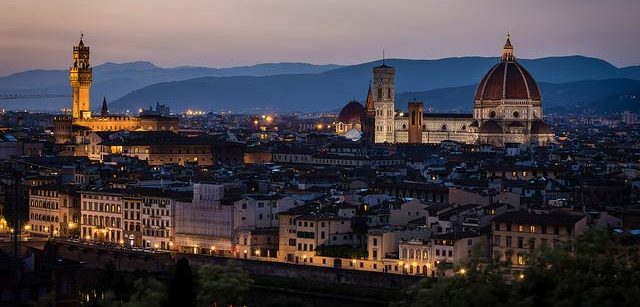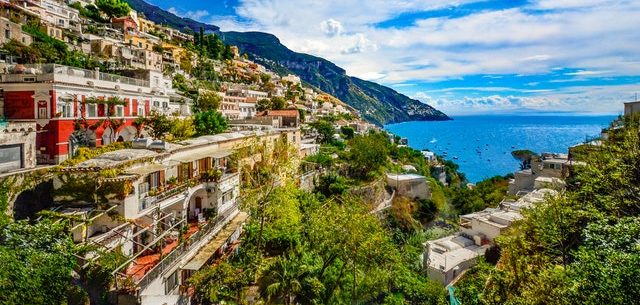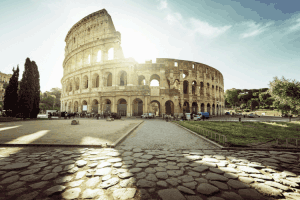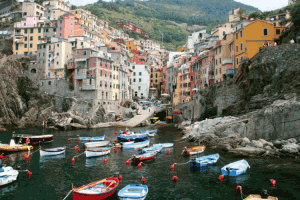A European holiday is a dream come true for many visitors. Teeming with an amazing assortment of fascinating countries, Europe offers something for all genre of travelers. Among these countries, Italy and Spain are both most popular destinations to visit in Europe.
Both Italy and Spain are beautiful destinations offering a harmonious blend of natural beauty, cultural immersion and heritage sights. Packed with amazing sightseeing, epicurean and cultural experiences, Spain and Italy both woo their guests with their unique charms.
But which of them is a better holiday destination? – You may wonder. Well, it all depends on what you want to experience on your European holiday. Spain and Italy are very similar but still feels totally different from each other. Let’s compare the two countries based on few prominent factors and figure out which one is the best.
Italy vs Spain Guide
1. Spain or Italy – Which Offers A Better Experience In Art And Architecture.

When you speak about European art and sculptures, Rome and Florence are two names that pop up in your mind. There is no doubt that Italy has an amazingly diverse and unique art collection and is a preferred destination to visit among art lovers. Italy offers you a remarkable world of famous masterpieces by renowned artists. It also captures the wonders of the Renaissance era and ancient Roman civilization in its historic ruins and monuments.
Spain, on the other hand, offers Baroque and Romanesque Spanish style architecture and is ranked second to list some marvelous buildings as UNESCO World Heritage Sites. Italy and Spain both give a glimpse of their grand historical years through their art and architecture. However, Italy is more popular among those how are keen to revisit the historical era and are ardent fans of art and heritage.
2. Spain vs Italy Weather – Which destination has Better Weather?

Spain is twice as big as Italy which means even the climate varies drastically than Italy. Different regions in Spain have different temperaments when it comes to weather. Italy also has varied weather throughout the year, but it mostly has stable seasons throughout its regions. Hence it is essential to keep note of the climate while planning a vacation to Spain or Italy.
Summers in Italy start around June till August, Autumn is from September till December, Winters from December to February and Spring starts in March until May. Spring is the best season to visit Italy as the weather is sunny yet pleasant for outdoor sightseeing. In Spain, you can plan your vacations in Spring and Fall as the climate is pleasantly warm during this time of the year. In fact, most of the year Spain has a warm and enjoyable subtropical climate famously known as the Mediterranean climate which is loved by tourists around the world.
3. Nature’s Splendor – What Country Offers the Best Landscapes?

Spain and Italy are both blessed with gorgeous natural landscapes. But Italy has a slighter advantage of being incredibly diverse in such a small place. This makes taking excursions to the countryside just a matter of a couple of hours from the Italian cities. The Tuscan countryside, lush vineyards of Lombardy and Piedmont, pristine lakes such as Lake Como and Lake Garda and Amalfi’s colorful coastal townships overlooking the deep blue waters are some of the incredibly scenic vistas that are worth visiting.
Spain also offers spectacular natural vistas, but it is more popular for its sun, sea, and sand. Spain is home to a breathtaking collection of Mediterranean islands such as Palma de Mallorca, The Canary Island, Ibiza to name a few and the famous beaches at Costa Del Sol are always the preferred spot for beach lovers and party goers. So, for romantic getaways, choosing Italy or Spain for the honeymoon can be a dilemma quite tough to decide.
4. Food Scene – Spanish siestas or Italy’s dolce vita?

Italy and Spain both love their food and are food havens for its visitors. The food culture is highly influenced by the local’s lifestyle and it plainly reflects their way of life. Italy serves guests with freshly baked pizzas, plates of pasta garnished in cheese and soups fused in herbs along with locally produced wines.
Spain is like a hen mother who loves to pamper its visitors with comfort food during siestas and its tapas bars are quite famous inspiring many other countries to follow suit. Lastly, don’t forget to try the desserts. In Italy, gorge on delicious gelatos of countless flavors and Spain dessert course such as mantecados, Crema Catalana and flans will leave you wanting for more. You would really have to call it a truce between both these destinations regarding their food delights as you really wouldn’t want to miss the epicurean treats both these countries have to offer.
5. Spain vs. Italy- Which Country is More Affordable?

Among Italy and Spain, the former is more expensive for tourists than the latter. This is one main reason for travelers to choose Spain over Italy. Both countries offer impressive transportation services of high-speed trains and a plethora of accommodation and dining options. However, the average cost of a basic accommodation in Italy is about 10 to 20 Euros higher than that of Spain. Additionally, countries needing a visa for Italy may face extra travel expenses and administrative processes, making Spain a more convenient option for some travelers.
Accommodation and food are quite cheap in Spain; even in major cities, you can easily find affordable and cheap options, unlike Italy where prominent cities might put stress on your wallet. For instance, Venice and Italian coastal towns are quite expensive as compared to Spain’s cities and townships. Thus, the expense factor makes Spain a much popular destination than Italy among budget travelers.
6. Spain vs. Italy – Which Country Has the Best Food?
When it comes to food, both Spain and Italy have outstanding reputations. Italy is world-famous for pizza, pasta, risotto, wine and desserts like tiramisu. Spanish cuisine shines with paella, tapas, jamón serrano, chorizo, and dishes that use olive oil, garlic and fresh seafood. While Italian food often relies more on cheese, cream and carbs, Spanish dishes tend to highlight fresh veggies and protein.
In the end it’s hard to say which country’s cuisine reigns supreme – they both offer tremendous regional variety and high quality ingredients. Spain may have an edge when it comes to affordability and casual dining thanks to its excellent tapas culture. But Italy combats this with excellent wine and decadent treats. Foodies certainly can’t go wrong visiting either destination.
7. Spain vs. Italy – Which Country Has the Best Culture & Lifestyle?
Both Spain and Italy have been shaped by thousands of years of vibrant, influential cultures and history. In Spain you can experience Moorish architecture and Islamic design, flamenco dancing with gypsy roots, stunning Cathedrals that merge Gothic, Baroque and Renaissance styles, and both modern and ancient art galleries.
Italy similarly wows visitors with millennia of groundbreaking artists, iconic landmarks from Roman aqueducts to Florentine Cathedrals, exquisite wines and perfumes, high fashion and timeless countryside hill towns. Lifestyle-wise Italy may feel more elegant and refined, while Spain has a more relaxed, casual vibe. But both offer epic festivals, buzzing nightlife, friendly locals, and that certain “dolce vita” energy.
8. Spain vs. Italy – Which Country Has the Best Activities?
Spain and Italy both offer tons of exciting things to do. Beach lovers flock to Spain’s gorgeous Costa del Sol, Costa Blanca, Canary Islands and Balearic Islands. Italy appeals more to skiers with the Alps and Dolomites. Both have spectacular hiking along ancient trails, whether the Camino de Santiago or Cinque Terre.
Spain offers vibrant Barcelona nightclubs and world-class Madrid museums like the Prado and Reina Sofía. Italy counters with opera in Verona, high fashion shopping in Milan, and sightseeing highlights like Pompeii and Rome’s Colosseum. Adrenaline junkies can try vertigo-inducing Mediterranean cliff diving in either locale. Nature lovers find diverse parks, reserves and volcanoes. History buffs dig Roman ruins, medieval towns and castles in Italy with centuries of stories to tell. Ultimately there’s zero change of boredom visiting either destination.
9. Spain vs. Italy – Which Country Is Easy to Get Around?
Spain arguably has an advantage when it comes to ease of transportation. Its high-speed AVE train whisks you between Madrid, Barcelona, Seville and other major hubs at nearly 200 mph speeds. The excellent intercity rail system also reaches smaller Spanish cities and towns reliably. Italy’s train network doesn’t cover the country quite as extensively or quickly, though high-speed lines are expanding. Buses help fill the gaps in both countries.
Renting a car provides freedom, though narrow, winding roads and hills present driving challenges. If you want to rely strictly on public transit, Spain has the most connected municipal networks, though cities like Rome and Milan have great subway and bus coverage. So first-time visitors nervous about getting around may find Spain a bit more beginner-friendly in that respect. Either way, it’s wise to consider transportation logistics when trip planning in both Spain and Italy.
Best time to visit Spain vs Italy
Thanks to a mostly warm, Mediterranean climate the optimal times for visiting Spain and Italy overlap considerably. Late spring through early fall spans the most comfortable conditions across both countries for outdoor sightseeing. Crowds and prices also remain lower in the shoulder seasons of early spring and late fall.
Both Spain and Italy host amazing festivals and events from about April through October too. Some key differences? Spain’s southern region stays beach-friendly nearly year-round if you don’t mind cooler ocean temps in winter. Italy’s Alps suit winter sports from November to March, and Venice keeps its magical allure even in colder months when the summer hordes dissipate.
No matter your travel style, target trips between March and June, or September to November, for pleasant weather with fewer tourists and hotels at the best value. July and August bring guaranteed sun along with intense heat, long lines, and premium pricing.
Comparing Top Destinations in Italy vs. Spain
1. Rome vs Barcelona
As capital cities of their respective countries, Rome and Barcelona make for an inevitable comparison. Full of history stretching back thousands of years, Rome was once the epicenter of the vast Roman Empire and remains littered with ancient ruins like the Colosseum and Roman Forum. As a cultural treasure trove, it also overflows with architectural marvels from Renaissance churches to the tiny country of Vatican City.
Barcelona feels newer and more modern, though still with ancient ruins and Gothic architecture blended with Gaudí’s surreal designs. Both cities tantalize the taste buds with their own regional cuisine, though Rome leans more traditional while Barcelona dazzles with molecular gastronomy. For nightlife Barcelona may have an edge with buzzing clubs and beaches. But for all-around sightseeing, Rome can’t be beat.
2. Tuscany vs Andalucía
Tuscany and Andalucía evoke idyllic images of sun-drenched vineyards, olive groves and hill towns seemingly frozen in time. And both regions produce superb wines—Brunello, Chianti and Montepulciano in central Italy’s gently rolling hills, compared to Sherry, Rioja and Tempranillo from Andalucía’s sunbaked plains and mountains.
Beyond the vineyards, charming towns like San Gimignano in Tuscany and Ronda in Andalucía will you transport you to medieval Europe with cobbled lanes and turreted architecture. Tuscany also lures with postcard-perfect cities like Florence and Lucca, while Andalucía boasts architectural wonders in Seville, Córdoba and Granada showcasing a diverse blend of Islamic, Gothic, Baroque and other influences unique to southern Spain. Either locale proves perfect for relaxing rural escapes, though Tuscany has more name recognition and buzz.
3. Italian Riviera vs Costa Brava
For beach bliss the glittering blue Mediterranean beckons whether you pick Italy or Spain. The rugged Italian Riviera packs visitors into fishing villages like Cinque Terre and Portofino in summer. Its pebbly beaches, terraced vineyards and scenic corniche roads never cease attracting sun seekers and jet setters to unwind along these iconic shores dotted with paparazzi.
Equally gorgeous, Costa Brava in northeastern Spain offers a more offbeat, affordable seaside experience with its still wild coves, virgin beaches and cultural sites from Salvador Dalí’s home to thousand-year-old monasteries. Resort towns like Sitges and Salou in the region also allure party people with throbbing clubs and packed sand, while idyllic Tossa de Mar provides a quieter refuge. Both coastal regions promise postcard-perfect vistas and delicious seafood. But Costa Brava’s variety suits more diverse tastes and budgets.
4. Venice vs Madrid
Two more bucket-list cities, Venice needs no introduction with its maze of canals winding past marble palaces and churches rising over teal lagoon waters. Madrid may seem more earthbound in landlocked central Spain. But the museums like Prado, Reina Sofía and Thyssen-Bornemisza compete with the best collections anywhere housing iconic masterpieces. The bars and restaurants sizzling up innovative tapas provide perfect pit stops between leafy plazas and parks with regal fountains and statues.
Shopping tempts along Gran Via’s luxury boutiques, side streets filled with flamenco apparel and taverns devoted to bullfighting gear. And few cities skylines match Madrid’s golden glow at sunset with rooftop bars overlooking the Palacio Real and distant mountains. For charm, Venice claims the prize. But for culture with vibrant contemporary energy woven into history, Madrid beguiles just as much.
Will this be a budget-friendly trip?
With proper planning, both Spain and Italy can make for a mostly budget-friendly vacation. You can easily control costs in Spain by sticking to affordable lodging like hostels or Airbnbs, using public transit, and enjoying the excellent value found at tapas bars and mid-range restaurants. Many Spanish attractions like parks, churches and beaches have free or very cheap entry fees. And even splurges like sipping sangria at a chic roof deck club generally come at more reasonable prices compared to elsewhere in Europe.
Italy offers greater variety, from very cheap eats at a pizzeria to five-star luxury hotels on Lake Como. Skipping the overpriced tourist traps around big sightseeing zones, and instead trying local neighborhood eateries, keeps dining budgets under control. You can also hunt for discounted or free museum entry opportunities.
But to make Italy truly affordable likely requires sacrificing some experiences – skipping the gondola ride in Venice, or not tasting the Brunello wines you came all the way to sample in Tuscany. Ultimately Spain gives budget travelers more wiggle room and still allows for an amazing trip.
Final Words
In conclusion, you can get the same experiences of heritage, food, and culture in Italy and Spain, but both countries offer it in their unique style. Spain is more expansive with its gorgeous vistas scattered amid different topography whereas Italy, though compact, packs a punch when it comes to viewing eclectic scenic sights.
If you wish to get a complete holiday experience of Spain, you may have to visit more than 6 to 9 destinations and your travel distance also increases. It may take about a week to explore most of Spain’s splendors. However, Italy can offer you its best sights in about 5 days and the travelling distance is also quite less as compared to Spain.
Nevertheless, you can even mix and match a few destinations from Spain and Italy to create your own unique European experience. This is easily possible as Italy and Spain both are part of the Schengen visa agreement and an Italy Visa will suffice for your Spain and Italy vacation. Both of them together makes a wonderful getaway from the day to day hustle, thanks to their idyllic lifestyle and tranquil ambiances.






